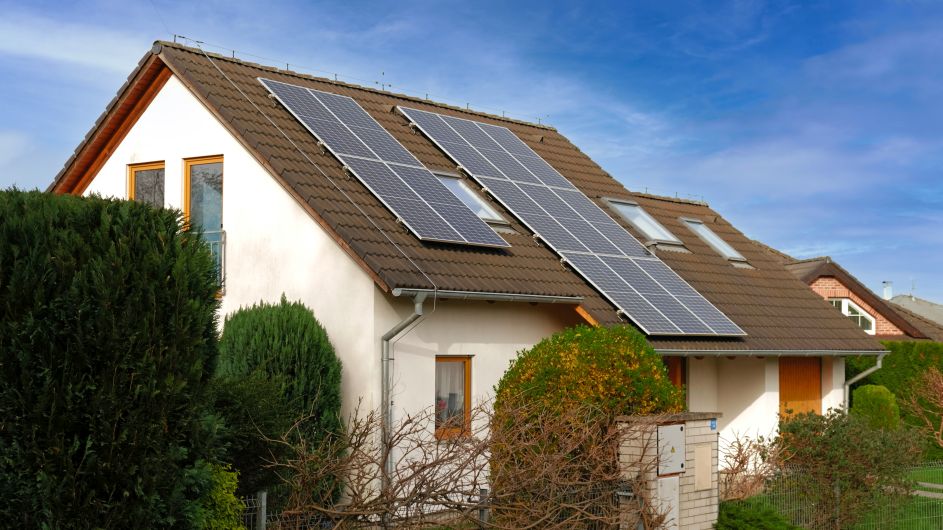For Massachusetts homeowners curious about switching to solar, one of the most common worries is whether trees, chimneys, or neighboring buildings might block sunlight and ruin efficiency. Shade is a real concern – too much of it can slash your system’s output and shorten its lifespan. At EcoSunWorks, we design every solar installation to work efficiently year-round, even in partially shaded environments, using advanced technology and smart system design to ensure you still get maximum savings.

Do Solar Panels Work in the Shade?
Here’s the thing – yes, solar panels do work in the shade, but not at full capacity. They can still produce electricity from indirect or reflected sunlight, but performance drops depending on how much and what kind of shade they’re under.
A small patch of shade from a tree branch can reduce output by 30–40%, and if your system uses a traditional “string” inverter setup, that one shaded panel can drag down the performance of the entire array – a bit like one bad battery in a flashlight.
How Shade Affects Solar Efficiency
Let’s break down what really happens when your panels aren’t getting full sun:
- Reduced Output: Shaded panels generate less power, and even partial shade can create a “bottleneck” effect across the system.
- Hot Spots: When part of a panel is shaded, the current may reverse, causing heat buildup that can damage cells over time.
- Shade Type Matters:
- Hard shade (like a chimney or thick tree limb) can cause a 50–70% loss.
- Soft shade (from thin clouds or nearby leaves) might only reduce output by 15–25%.
Can Solar Panels Work Without Direct Sunlight?
Absolutely – solar panels don’t need blazing sunshine all day long. They can still generate power from diffused light during cloudy or overcast days, though production is lower. Think of it as a dimmer version of sunlight – enough to keep generating energy, just not at full strength.
How Much Sunlight Do Solar Panels Need?
On average, solar panels perform best with at least 4–5 hours of direct sunlight per day. In Massachusetts, where weather varies throughout the year, your installer can design your system using solar modeling tools that track shade patterns and seasonal sun angles to ensure optimal placement.

Smart Solutions for Shaded Roofs
Not every home has a wide-open roof – and that’s okay. Technology has evolved to help homeowners make solar work even with shade challenges.
1. Microinverters or Power Optimizers
Instead of connecting all panels in one string, these devices allow each panel to operate independently. So if one panel is shaded, the rest keep producing efficiently. This setup is perfect for homes with trees or multiple roof angles.
2. Bifacial Panels
These panels collect sunlight from both sides, capturing light reflected off nearby surfaces (like your roof or driveway). It’s an excellent option if your property gets partial shade.
3. Smart System Design
At EcoSunWorks, we use advanced shade analysis tools to predict how sunlight moves across your roof throughout the year. That means your solar array is positioned for maximum sun exposure – and minimal power loss.
How to Tell If Your Roof Is Too Shaded for Solar
You can do a quick check by observing your roof during peak sunlight hours (10 AM–3 PM). If more than half the surface is shaded most of the time, it’s worth having a professional assessment. Tools like the Solar Pathfinder or Solmetric SunEye can map shade precisely and show you potential production losses before installation.
Local Tip: Massachusetts Tree Growth
Many Massachusetts neighborhoods have tall maples and oaks that can cast long shadows – especially in winter when the sun sits lower. The good news? EcoSunWorks’ local solar experts know these conditions well and plan installations with seasonal sun angles in mind. If needed, we’ll recommend selective trimming or repositioning for the best long-term results.
The Bottom Line: Shade Isn’t a Dealbreaker
Shade can reduce your solar system’s performance, but it doesn’t have to stop you from going solar. With microinverters, smart planning, and professional design, you can still enjoy strong returns and clean energy independence – even under partly shaded conditions.
If you’re unsure how much shade your roof gets or how it might affect your potential savings, EcoSunWorks can perform a free on – site or virtual solar analysis to give you clear answers before you invest.
Click here to Read more about Direct Sunlight vs Shading
Get Your free Solar Estimate Today or Call us at 833-617-0738
